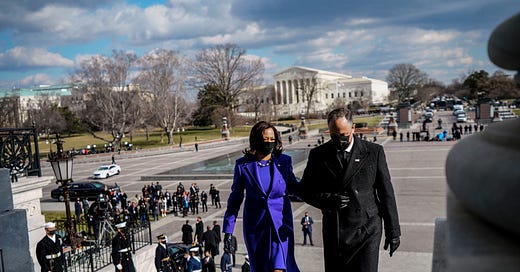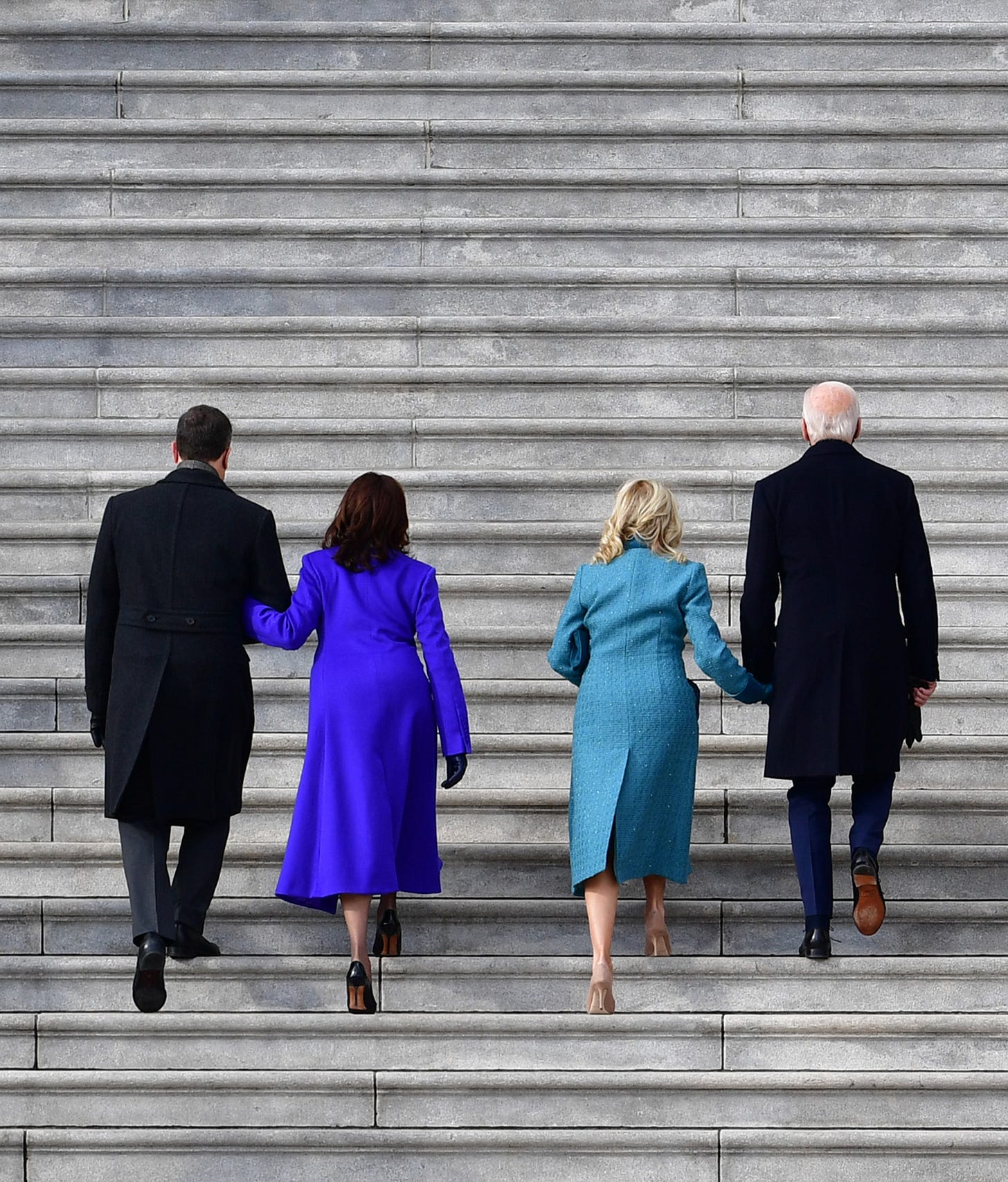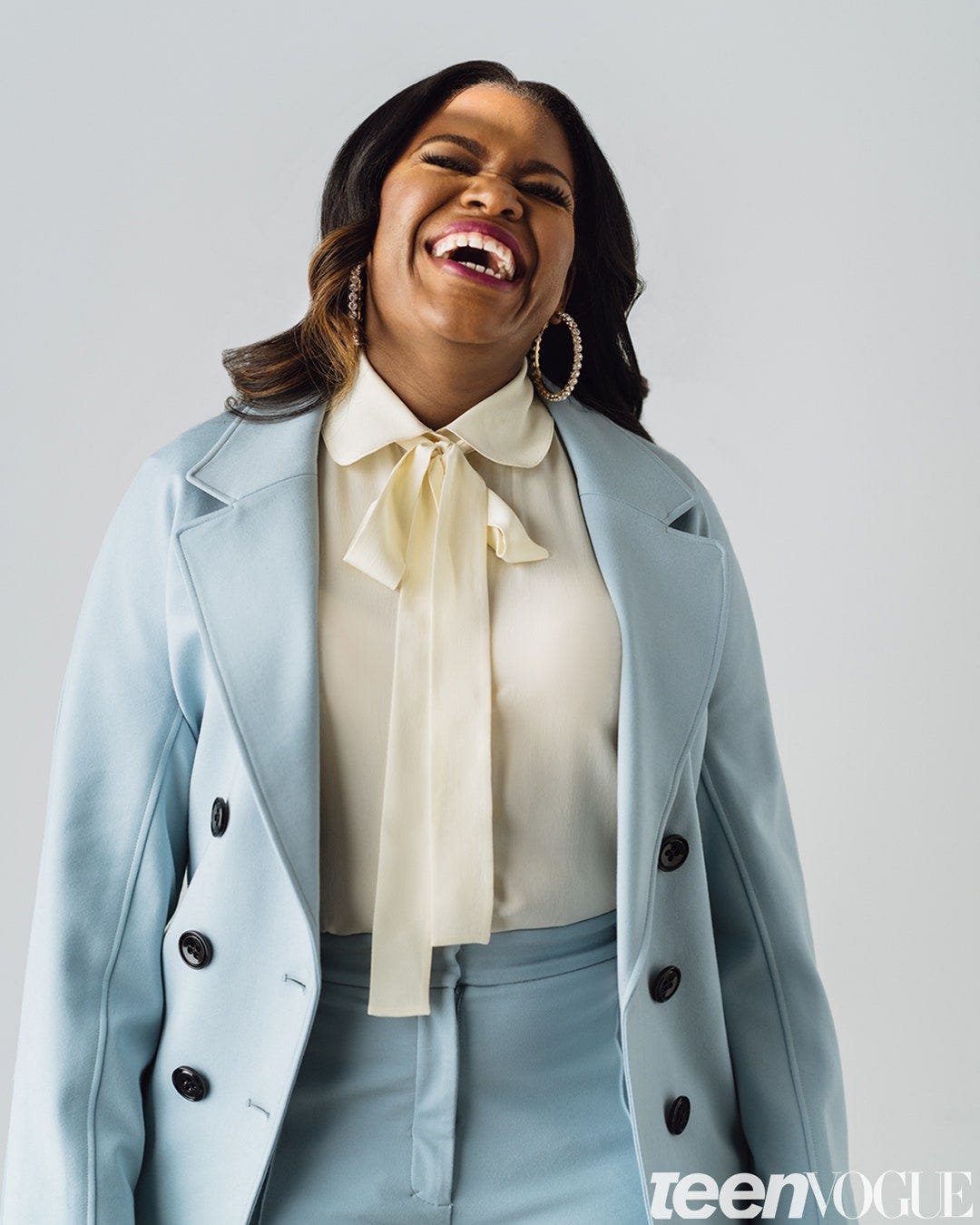Should We Really Care About What Politicians Are Wearing?
Despite a global pandemic and a nation in disarray, fashion somehow took center stage at the inauguration.
Hi there!
I’m back this weekend—and I couldn’t help but devote this one to the Fashion of the Inauguration. As we move forward with the Biden administration, I wonder if there’s going to be a sustained interest around our Vice President’s clothes…and if that isn’t a little bit thorny. To help me sort out my thoughts, I spoke to two fashion experts—The Washington Post’s Robin Givhan (aka, the Queen of Criticism) and BoF’s Lauren Sherman (also, Queen). I loved what they had to say and hope you do, too. Before you get started, just a reminder that these weekend digests will be reserved only for paying subscribers in just a couple of weeks! I’d love your support, if you’re able. For now, though, happy weekend and enjoy.
xxPP
A specter loomed over Inauguration Day. Exactly two weeks prior, armed insurrectionists forcibly occupied the United States Capitol, brandishing weapons and white supremacist insignia, to try and subvert the results of the presidential election. Intelligence officials warned that there were credible threats planned for the inauguration of Joe Biden, but the President-elect stood firm: the ceremony would move forward as planned.
Miraculously (or not so miraculously—Washington, DC effectively became an occupied military zone), the inauguration went off without a hitch. The celebration, while jubilant, was at times comfortably boring, making it a marked departure from the grotesque made-for-television speeches and atrocious public displays of the Trump administration. A nation full of people still stuck at home (due to the twin crises of misinformation and the coronavirus) watched and shared their commentary on social media. The star of the show was not President Joe Biden, nor was it the historically twice-impeached and glaringly absent Donald Trump. It wasn’t even Jennifer Lopez, Lady Gaga, Vice President Kamala Harris, or Michelle Obama. The star, somehow, was the fashion.
“Inauguration was really a peacoat Verzuz,” one Twitter user wrote, capturing the sentiment of the celebration. Bernie Sanders, sitting cross-legged and wearing locally-sourced hand-knit mittens, became a meme. Michelle Obama was also a frequent meme, with users comparing her facial expressions and somber attire from Trump’s inauguration to the luxurious, monochromatic glamour and flowing hair she sported for Biden’s. The poet Amanda Gorman, another breakout star of the day, seized the moment with her beautiful verse—and, of course, a canary yellow Prada coat. Dr. Jill Biden looked every bit the first lady in a shimmering cerulean coat and dress by Markarian. And Vice President Kamala Harris made history, both with her swearing in and with her wardrobe choice: a royal purple ensemble by Christopher John Rogers, a young Black designer from New York. Not to be upstaged, of course, was President Biden, who struck a classic, trim silhouette in a navy Ralph Lauren suit—an aesthetic balm to Trump’s slovenly tailoring and unkempt appearance of the last four years. The President’s choice of watch for the occasion—a Rolex Datejust—would also prompt a New York Times headline (and, later, an internet uproar).
As someone who loves fashion, I was thrilled to see the celebration of style that was on display. On the one hand, I felt overjoyed for Christopher John Rogers, Kerby Jean-Raymond of Pyer Moss, Gabriela Hearst, and the countless other designers who would undoubtedly benefit greatly from these history-making moments. On the other, I felt uneasy. We were supposed to walk away from the past four years of abused democracy with a greater consciousness—an awareness that there can be no “back to normal,” since “normal” in America meant blatant inequality, before, during, and after Trump. I worried that this all could read as a proverbial “going back to brunch”—a nod to the 2017 Women’s March signs which stated that if Hillary Clinton were elected, we’d have fun and relaxing lives and would not be out in the streets protesting. The threats to our democracy—and the systemic racism, transphobia, and misogyny that underpin all of our American institutions—are not going anywhere just because there’s been a changing of the guard.
Lauren Sherman, chief correspondent at the Business of Fashion, also felt that the fashion fanfare “felt more intense” during the inauguration than, say, the Obama years. But that’s “compounded,” she says, by the fact that “we haven’t had many public events this year: zero red carpets, really. So there’s the public appetite to gaze and marvel at fashion.” Not only has there been a dearth of events this year, there’s also been a complete absence of joy for the past four. Every event that Trump oversaw was marked by vitriol and vengeance. Finally, it felt like there was cause for celebration.
The public’s desire to look at, admire, and critique the fashion of White House politicians is a longstanding tradition, epitomized by First Ladies like Jackie Kennedy and Michelle Obama. But, Sherman points out, there was a reluctance among fashion enthusiasts (themselves, often left-leaning) to dissect or celebrate the style of Melania Trump. “It felt very heavy and often laborious,” Sherman says, “often because of the negative message she was sending with certain garments.” André Leon Talley, the famed author and fashion editor, struck a similar note on Instagram, referring to Mrs. Trump as an “empty vessel of glamour” who looked like she had “opened up a FedEx box and piled on the labels.” His point being, perhaps, that there’s a difference between being fashionable and being stylish; the former meaning one wears nice clothes, the latter meaning one says something about themselves with their clothes.
That’s precisely the difference between the vapid, Dolce & Gabbana glamour of Melania Trump and the stylistic expressions currently displayed on the American political stage. Sherman refers to this as “the Michelle Obama playbook,” while Voguecalls it “fashion diplomacy.” There’s a message not just in the color or the style being worn (see: purple representing the unity of red and blue, or Hillary Clinton’s suffragette-inspired white pantsuit) but also in celebrating who makes the garments on display.
“Choosing a Pyer Moss coat or an ensemble by Christopher John Rogers or Prabal Gurung is making a statement,” says Robin Givhan, the Pulitzer Prize winning journalist and senior critic-at-large for The Washington Post. “These are all brands with a particular social or cultural outlook.” Pyer Moss and Christopher John Rogers are two Black designers with independent fashion businesses, while Prabal Gurung is a Nepalese-American designer whose runway shows have featured commentary ranging from supporting immigration to women’s empowerment. Sporting American designers, for one, supports an industry that has been badly bruised by the coronavirus pandemic. But to support Black- or immigrant-owned businesses after a period of prolonged attacks on civil rights seems, at least on its face, a declaration of one’s values.
Then there’s the fact that this year, the most fashion fanfare has been directed towards Vice President Kamala Harris. But with that honor, VP Harris may also make history as the most aesthetically scrutinized Vice President ever. The question begs itself: Is it actually productive for us to be commenting on the appearance of the most powerful woman in America? “It’s funny to me that so many people seem to be asking this question specifically about Harris,” Givhan says. “They don’t seem as tortured about paying attention to the First Lady’s wardrobe.”
Nonetheless, she concedes, “I completely understand the hesitation. Supporters don’t want anything to diminish her stature or to shift the focus from her accomplishments or the daunting work ahead. And I would also argue that we should be cautious about treating her like a First Lady or a celebrity. At the moment, she is one-of-a-kind.”
That’s at least part of the reason why Vogue’s cover of the Vice President sparked such outrage earlier this month. Givhan, in a widely praised op-ed, called it “a cause for disappointment” that “did not give Kamala D. Harris due respect.”
“Nothing about the cover said, ‘Wow,’” she wrote. “And sometimes, that’s all Black women want, an admiring and celebratory ‘wow’ over what they have accomplished.” A one-of-a-kind woman—especially one making hard-won American history—demands a one-of-a-kind perspective.
There’s a valuable lesson here. Just like Givhan admonished the Vogue cover for being “too familiar,” she does the same for the rest of us as spectators. “Hopefully we’ll recognize when we’re going too far. Before we start turning [the Vice President] into a fashion icon, we need to let her be an American trailblazer first,” she says.
Of course, that doesn’t mean the clothes don’t matter, don’t carry a message, or aren’t worthy of a closer look. “I think [Vice President Harris] looks sophisticated and modern, feminine and confident,” Givhan adds. “When people get worked up about [her] overcoat, we have to ask: Is it the coat that’s making people excited? Or is the coat just a way to admire who and what she is and what she stands for?”
It’s this point that sticks the most. Most people commenting on the clothing of the First Lady or the Vice President aren’t doing so because “all they care about is fashion,” or because they’re delusional enough to think that, with Biden as President, things will magically become better.
Instead, after four years of holding anything but reverence for the people in the White House, maybe all the fanfare about fashion indicates that people really, desperately needed to lean into optimism. And isn’t it a treat, among so much tragedy, to be able to take in the deliberate symbolism behind some beautiful clothes?
I have full faith that the lessons of the last four years—and the ongoing lessons of the coronavirus pandemic—will have a lasting impact on the American consciousness. Rather, I hope we can comfortably lean into joy (and allow others to do so) in an effort to refill our tanks. After the past four years, certainly we deserve that. Let’s just be careful not to let the cashmere get pulled over our eyes.
Three Other Joy-Bringing Things from This Week:
So long as we’re on the topic of Fashion and Politics, I’d be remiss not to celebrate Teen Vogue’s latest cover story of Representative Cori Bush. What a fantastic statement for the magazine to make—supporting a newly elected Black woman who’s quickly becoming a force to reckon with in DC—and a timely one, at that.
This cover is the first to air after the departure of Teen Vogue’s editor-in-chief, Lindsay Peoples Wagner, was announced via The New York Times. It is also a major win for Samhita Mukhopadhyay, the brand’s executive editor, who has been ramping up and polishing the politics vertical since her arrival in 2018. It’s stunning to continue to see how Teen Vogue, a publication far less resourced than most at Condé Nast, remains on the pulse of the moment. I hope that whoever the new editor is carefully considers that a lifestyle title cannot be reflective of the culture without rooting itself in the values of its audience—and that those values may often be at odds with certain pressures towards palatability. I am wishing them the very best.
The other breakout star of the Inauguration, Amanda Gorman, has three books coming out in the near future! I first met Amanda when I was orchestrating Teen Vogue’s inaugural 21 Under 21, and she was every bit as incredible then as she is now. You can pre-order The Hill We Climb: Poems from Bookshop.org.
So long as we’re talking about Fashion, I found an Instagram user (via a stylist I follow) who sources vintage jewelry and sells it for extremely reasonable prices. I’ve already bought two pairs of earrings from her—one a 14K gold/topaz huggie and another, a rainbow crystal drop moment—and I am very pleased.
Reluctantly, I am sharing her account because I want the best for her. (But I swear, if she posts pearl drop earrings and you get to them before I do, I will fight you.)
NOW READING: I just wrapped Feline Philosophy: Cats and the Meaning of Life, and I’m still making my way through the I Ching. Up next, The Faggots & Their Friends Between Revolutions by Larry Mitchell. (And I’m tackling some Jung on audio—is anyone else having bizarre dreams lately?!)
PARTING WORDS:
On January 20, 1993, Maya Angelou delivered the Inaugural Poem for Bill Clinton’s ceremony. For the occasion, Oprah Winfrey bought her a Chanel coat and gloves—a tradition she hoped to repeat with Amanda Gorman, who had the honor of reading the poem at this year’s ceremony. Gorman’s outfit was already selected (by Prada, no big deal), so Winfrey chose to buy her a ring and a pair of earrings instead. The ring, a golden sculpture of a little bird in a cage, was an homage to Ms. Angelou’s iconic book. Here, a brief excerpt from Angelou’s poem “On the Pulse of Morning,” which you can read in full here.
“History, despite its wrenching pain
Cannot be unlived, but if faced
With courage, need not be lived again.
Lift up your eyes upon
This day breaking for you.
Give birth again
To the dream.”








